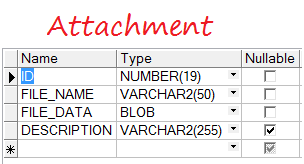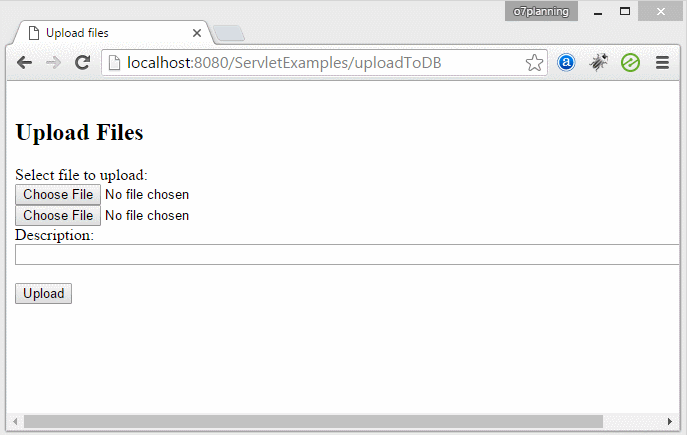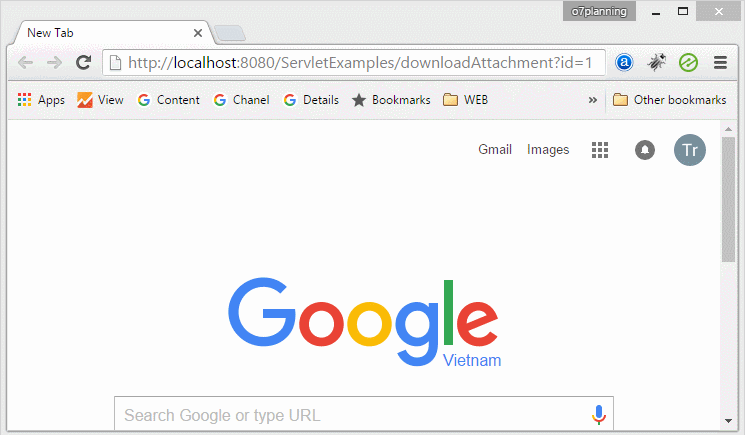Laden Sie mit Java Servlet Dateien aus der Datenbank hoch und laden Sie sie herunter
1. Database

** ORACLE **
create table ATTACHMENT
(
ID NUMBER(19) not null,
FILE_NAME VARCHAR2(50) not null,
FILE_DATA BLOB not null,
DESCRIPTION VARCHAR2(255)
) ;
alter table ATTACHMENT
add constraint ATTACHMENT_PK primary key (ID) ;** MYSQL **
create table ATTACHMENT
(
ID BIGINT not null,
FILE_NAME VARCHAR(50) not null,
FILE_DATA BLOB not null,
DESCRIPTION VARCHAR(255)
) ;
alter table ATTACHMENT
add constraint ATTACHMENT_PK primary key (ID) ;** SQL SERVER **
create table ATTACHMENT
(
ID BIGINT not null,
FILE_NAME VARCHAR(50) not null,
FILE_DATA Varbinary(max) not null,
DESCRIPTION VARCHAR(255)
) ;
alter table ATTACHMENT
add constraint ATTACHMENT_PK primary key (ID) ;2. Aus Database hochladen und herunterladen
Im Dokument führe ich Sie, eine File hochzuladen und in Database zu speichern danach die Daten aus Database herunterzuladen. Die hochgeladeten File Daten wird in der Spalte mit dem Datentyp BLOB gespeichert.
Sie können irgendeine Database benutzen. Oben ist es ein Script der Tabellenerstellung ATTACHMENT. Diese Tabelle archiviert die Filedaten, die von Ihnen hochgeladet werden
Sie können irgendeine Database benutzen. Oben ist es ein Script der Tabellenerstellung ATTACHMENT. Diese Tabelle archiviert die Filedaten, die von Ihnen hochgeladet werden
Sie können mehr studieren, wie man die JDBC benutzt um mit Database zu verbinden bei ...
3. In DB hochladen und speichern
UploadToDBServlet.java
package org.o7planning.servletexamples;
import java.io.IOException;
import java.io.InputStream;
import java.sql.Connection;
import java.sql.PreparedStatement;
import java.sql.ResultSet;
import java.sql.SQLException;
import javax.servlet.RequestDispatcher;
import javax.servlet.ServletException;
import javax.servlet.annotation.MultipartConfig;
import javax.servlet.annotation.WebServlet;
import javax.servlet.http.HttpServlet;
import javax.servlet.http.HttpServletRequest;
import javax.servlet.http.HttpServletResponse;
import javax.servlet.http.Part;
import org.o7planning.tutorial.jdbc.ConnectionUtils;
@WebServlet("/uploadToDB")
@MultipartConfig(fileSizeThreshold = 1024 * 1024 * 2, // 2MB
maxFileSize = 1024 * 1024 * 10, // 10MB
maxRequestSize = 1024 * 1024 * 50) // 50MB
public class UploadToDBServlet extends HttpServlet {
private static final long serialVersionUID = 1L;
@Override
protected void doGet(HttpServletRequest request, HttpServletResponse response)
throws ServletException, IOException {
RequestDispatcher dispatcher = request.getServletContext().getRequestDispatcher("/WEB-INF/jsps/uploadToDB.jsp");
dispatcher.forward(request, response);
}
@Override
protected void doPost(HttpServletRequest request, HttpServletResponse response)
throws ServletException, IOException {
Connection conn = null;
try {
// Connection to Database
// (See more in JDBC Tutorial).
conn = ConnectionUtils.getMyConnection();
conn.setAutoCommit(false);
String description = request.getParameter("description");
// Part list (multi files).
for (Part part : request.getParts()) {
String fileName = extractFileName(part);
if (fileName != null && fileName.length() > 0) {
// File data
InputStream is = part.getInputStream();
// Write to file
this.writeToDB(conn, fileName, is, description);
}
}
conn.commit();
// Upload successfully!.
response.sendRedirect(request.getContextPath() + "/uploadToDBResults");
} catch (Exception e) {
e.printStackTrace();
request.setAttribute("errorMessage", "Error: " + e.getMessage());
RequestDispatcher dispatcher = getServletContext().getRequestDispatcher("/WEB-INF/jsps/uploadToDB.jsp");
dispatcher.forward(request, response);
} finally {
this.closeQuietly(conn);
}
}
private String extractFileName(Part part) {
// form-data; name="file"; filename="C:\file1.zip"
// form-data; name="file"; filename="C:\Note\file2.zip"
String contentDisp = part.getHeader("content-disposition");
String[] items = contentDisp.split(";");
for (String s : items) {
if (s.trim().startsWith("filename")) {
// C:\file1.zip
// C:\Note\file2.zip
String clientFileName = s.substring(s.indexOf("=") + 2, s.length() - 1);
clientFileName = clientFileName.replace("\\", "/");
int i = clientFileName.lastIndexOf('/');
// file1.zip
// file2.zip
return clientFileName.substring(i + 1);
}
}
return null;
}
private Long getMaxAttachmentId(Connection conn) throws SQLException {
String sql = "Select max(a.id) from Attachment a";
PreparedStatement pstm = conn.prepareStatement(sql);
ResultSet rs = pstm.executeQuery();
if (rs.next()) {
long max = rs.getLong(1);
return max;
}
return 0L;
}
private void writeToDB(Connection conn, String fileName, InputStream is, String description) throws SQLException {
String sql = "Insert into Attachment(Id,File_Name,File_Data,Description) " //
+ " values (?,?,?,?) ";
PreparedStatement pstm = conn.prepareStatement(sql);
Long id = this.getMaxAttachmentId(conn) + 1;
pstm.setLong(1, id);
pstm.setString(2, fileName);
pstm.setBlob(3, is);
pstm.setString(4, description);
pstm.executeUpdate();
}
private void closeQuietly(Connection conn) {
try {
if (conn != null) {
conn.close();
}
} catch (Exception e) {
}
}
}UploadToDBResultsServlet.java
package org.o7planning.servletexamples;
import java.io.IOException;
import javax.servlet.RequestDispatcher;
import javax.servlet.ServletException;
import javax.servlet.annotation.WebServlet;
import javax.servlet.http.HttpServlet;
import javax.servlet.http.HttpServletRequest;
import javax.servlet.http.HttpServletResponse;
@WebServlet("/uploadToDBResults")
public class UploadToDBResultsServlet extends HttpServlet {
private static final long serialVersionUID = 1L;
public UploadToDBResultsServlet() {
super();
}
@Override
protected void doGet(HttpServletRequest request, HttpServletResponse response)
throws ServletException, IOException {
RequestDispatcher dispatcher
= request.getServletContext().getRequestDispatcher("/WEB-INF/jsps/uploadToDBResults.jsp");
dispatcher.forward(request, response);
}
}/WEB-INF/jsps/uploadToDB.jsp
<!DOCTYPE >
<html>
<head>
<title>Upload files</title>
</head>
<body>
<div style="padding:5px; color:red;font-style:italic;">
${errorMessage}
</div>
<h2>Upload Files</h2>
<form method="post" action="${pageContext.request.contextPath}/uploadToDB"
enctype="multipart/form-data">
Select file to upload:
<br />
<input type="file" name="file" />
<br />
<input type="file" name="file" />
<br />
Description:
<br />
<input type="text" name="description" size="100" />
<br />
<br />
<input type="submit" value="Upload" />
</form>
</body>
</html>/WEB-INF/jsps/uploadToDBResults.jsp
<!DOCTYPE >
<html>
<head>
<title>Upload files</title>
</head>
<body>
<h3>Upload has been done successfully!</h3>
<a href="${pageContext.request.contextPath}/uploadToDB">Continue Upload</a>
</body>
</html>Führen Sie die Applikation durch

Die File werden in der Tabelle Attachment hochgeladet und archiviert

4. Aus Database herunterladen
DownloadAttachmentServlet.java
package org.o7planning.servletexamples;
import java.io.IOException;
import java.io.InputStream;
import java.sql.Blob;
import java.sql.Connection;
import java.sql.PreparedStatement;
import java.sql.ResultSet;
import java.sql.SQLException;
import javax.servlet.ServletException;
import javax.servlet.annotation.WebServlet;
import javax.servlet.http.HttpServlet;
import javax.servlet.http.HttpServletRequest;
import javax.servlet.http.HttpServletResponse;
import org.o7planning.servletexamples.model.Attachment;
import org.o7planning.tutorial.jdbc.ConnectionUtils;
@WebServlet("/downloadAttachment")
public class DownloadAttachmentServlet extends HttpServlet {
private static final long serialVersionUID = 1L;
@Override
protected void doGet(HttpServletRequest request, HttpServletResponse response)
throws ServletException, IOException {
Connection conn = null;
try {
// Get Database Connection.
// (See more in JDBC Tutorial).
conn = ConnectionUtils.getMyConnection();
Long id = null;
try {
id = Long.parseLong(request.getParameter("id"));
} catch (Exception e) {
}
Attachment attachment = getAttachmentFromDB(conn, id);
if (attachment == null) {
// No record found.
response.getWriter().write("No data found");
return;
}
// file1.zip, file2.zip
String fileName = attachment.getFileName();
System.out.println("File Name: " + fileName);
// abc.txt => text/plain
// abc.zip => application/zip
// abc.pdf => application/pdf
String contentType = this.getServletContext().getMimeType(fileName);
System.out.println("Content Type: " + contentType);
response.setHeader("Content-Type", contentType);
response.setHeader("Content-Length", String.valueOf(attachment.getFileData().length()));
response.setHeader("Content-Disposition", "inline; filename=\"" + attachment.getFileName() + "\"");
// For big BLOB data.
Blob fileData = attachment.getFileData();
InputStream is = fileData.getBinaryStream();
byte[] bytes = new byte[1024];
int bytesRead;
while ((bytesRead = is.read(bytes)) != -1) {
// Write image data to Response.
response.getOutputStream().write(bytes, 0, bytesRead);
}
is.close();
} catch (Exception e) {
throw new ServletException(e);
} finally {
this.closeQuietly(conn);
}
}
private Attachment getAttachmentFromDB(Connection conn, Long id) throws SQLException {
String sql = "Select a.Id,a.File_Name,a.File_Data,a.Description "//
+ " from Attachment a where a.id = ?";
PreparedStatement pstm = conn.prepareStatement(sql);
pstm.setLong(1, id);
ResultSet rs = pstm.executeQuery();
if (rs.next()) {
String fileName = rs.getString("File_Name");
Blob fileData = rs.getBlob("File_Data");
String description = rs.getString("Description");
return new Attachment(id, fileName, fileData, description);
}
return null;
}
private void closeQuietly(Connection conn) {
try {
if (conn != null) {
conn.close();
}
} catch (Exception e) {
}
}
}Führen Sie die Applikation durch

Anleitungen Java Servlet/JSP
- Installieren Sie Tomcat Server für Eclipse
- Installieren Sie Glassfish Web Server unter Windows
- Führen Sie die Maven Java-Webanwendung im Tomcat Maven Plugin aus
- Führen Sie die Maven Java-Webanwendung im Jetty Maven Plugin aus
- Ausführen einer Hintergrundaufgabe in der Java Servlet-Anwendung
- Die Anleitung zum Java Servlet für den Anfänger
- Die Anleitung zu Java Servlet Filter
- Die Anleitung zum Java JSP für den Anfänger
- Die Anleitung zu Java JSP Standard Tag Library (JSTL)
- Installieren Sie WebToolsPlatform für Eclipse
- Erstellen Sie eine einfache Anmeldeanwendung und sichere Seiten mit Java Servlet Filter
- Erstellen Sie eine einfache Java Web Application mit Servlet, JSP und JDBC
- Hochladen und Herunterladen von Dateien die auf der Festplatte mit Java Servlet gespeichert sind
- Laden Sie mit Java Servlet Dateien aus der Datenbank hoch und laden Sie sie herunter
- Bild von Datenbank mit Java Servlet anzeigen
- Redirect 301 Permanentes Umleiten in Java Servlet
- Wie automatisch http auf https in einer Web-Anwendung Java umleiten?
- Verwenden Sie Google reCAPTCHA in der Java-Webanwendung
Show More